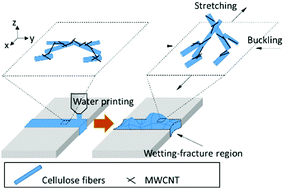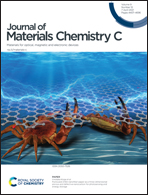Electromechanical coupling of isotropic fibrous networks with tailored auxetic behavior induced by water-printing under tension†
Abstract
Understanding the electromechanical coupling of auxetic materials offers unique opportunities to enhance the sensitivity of piezoresistive sensors. Reports on the auxetic behavior of random fiber networks have been relatively scarce due to their less pronounced Poisson's expansions than other auxetic designs adapting periodically arranged structures. In this study, the auxetic response of hierarchical pulp-carbon nanotube networks is tailored through the localized tensional micro-fracture initiated by water-printing. The interfacial junctions among multiwalled carbon nanotubes (MWCNTs) and cellulose fibers are disintegrated and reorganized to induce the buckling of a wet CNT paper composite (CPC) network. The Poisson's ratio of −49.5 is achieved at the water-printed region. The resulting piezoresistive properties of CPC sensors exhibit high sensitivity (3.3 kPa−1) over a wide dynamic range (6–500 000 Pa). The novel auxetic behavior of water-printed CPC paves the way for high performance and inexpensive wearable devices.



 Please wait while we load your content...
Please wait while we load your content...